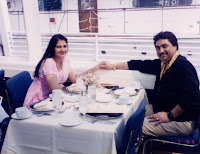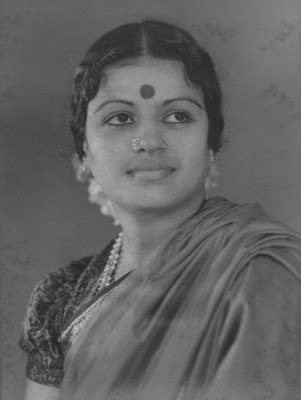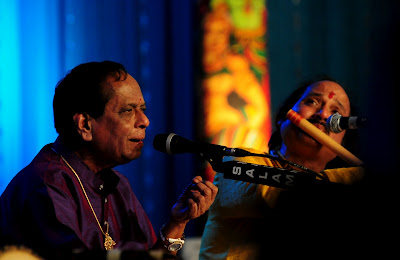Jagjit Singh, born Jagmohan Singh (8 February 1941 – 10 October 2011), was a prominent Indian Ghazal singer, songwriter and musician. Known as the "Ghazal King", he gained acclaim together with his wife, another renowned Indian ghazal singer Chitra Singh in the 1970s and 1980s. Their combination album comprising music from the films, Arth and Saath Saath is the HMV's largest selling combination album of all time. Sajda (An Offering, 1991), Jagjit Singh's magnum opus double album with Lata Mangeshkar holds the same record in non-film category. He sang in numerous languages. He was awarded the Padma Bhushan by the government of India in 2003.
Singh is credited for the revival and popularity of ghazal, an Indian classical art form, by choosing poetry that was relevant to the masses and composing them in a way that laid more emphasis on the meaning of words and melody evoked by them. In terms of Indian Classical music, his style of composing and Gayaki (singing) is considered as Bol-pradhan, one that lays emphasis on words. He highlighted this in his music for films such as Prem Geet (1981), Arth and Saath Saath (1982), and TV serials Mirza Ghalib (1988) and Kahkashan (1991). Jagjit Singh is considered to be the most successful ghazal singer and composer of all time in terms of critical acclaim and commercial success. With a career spanning over five decades and a repertoire comprising over 80 albums,[1] the range and breadth of his work has been regarded as genre-defining. He is the only composer and singer to have composed and recorded songs written by Prime Minister Atal Behari Vajpayee — also a critically acclaimed poet — in two albums, Nayi Disha (1999) and Samvedna (2002).
Singh's 1987 album, Beyond Time, was the first digitally recorded release in India. He was regarded as one of India's most influential artistes. With sitar legend Ravi Shankar and other leading figures of Indian classical music and literature, Singh voiced his concerns over politicisation of arts and culture in India and lack of support experienced by the practitioners of India's traditional art forms, particularly folk artists and musicians. He lent active support to several philanthropic endeavors such as the library at St. Mary's School, Mumbai, Bombay Hospital, CRY, Save the Children and ALMA.
Early Life And Career

Jagjit Singh was born on 8 February 1941 in Sri Ganganagar, Rajasthan, India. His birth name was Jagmohan but this was changed to Jagjit after his parents sought the advice of a member of the Sikh Namdhari sect. His parents were Sikhs — Amar Singh and Bachan Kaur — and had several other children, with sources variously reporting the number between six and eleven.
Educated initially at Khalsa High School and Sri Ganganagar Government College, Singh obtained an arts degree from DAV College at Jalandhar and then a post-graduate degree in history from Kurukshetra University in Haryana. Throughout this time, and as a consequence of a natural talent that was spotted by his father, Singh learned music in Sikh temples and from musicians such as Pandit Chaganlal Sharma and Ustad Jamaal Khan, both of whom were trained in classical Indian music. He performed on radio and on stage, as well as composing some material, although he subsequently claimed that his father, who was a government employee, had hoped that he would become an engineer. On another occasion his memory was that his father aspired for him to become a bureaucrat and that his siblings were encouraged musically.
In March 1965, and without the knowledge of his family,Singh moved to Mumbai, where there were many opportunities for music artists because of the Bollywood film industry. He obtained work initially as a singer of advertising jingles and later progressed to playback singing.In the same year he persuaded the record company HMV to produce an EP; he also altered his Sikh image by abandoning his turban, shaving and cutting his hair. His first film role was in Dharati Na Chhoru, a Gujarati production by Suresh Amin.
Fame

Singh was still struggling to make a living in 1967 when he met the Bengali-born Chitra Dutta.She was also a jingle singer and was unhappily married with a daughter. She divorced her husband and married Singh in December 1969.Following the birth of their son, Vivek, the couple performed as a singing duo but it was not until the 1976 release of the album The Unforgettables that they found significant, and surprising, success. In the interval, the primary difficulty for them had been that the ghazal music genre was dominated by Muslim artists and especially those from Pakistan.
The Unforgettables, which was the couple's first LP, was an unconventional recording and it turned them into stars. The song "Baat Niklegi" from the album achieved great popularity for the Singhs. The Independent described it in 2011 as "ground-breaking ... it became a transformative, before-and-after milestone in the history of Indian popular and ghazal music. It remains that." Using modern arrangements, it consists of ten tracks that include two on which they sang as a duo and the remainder equally split between Jagjit and Chitra singing the lead. The Independent further noted that "This format of solo and duet performances from the first commercially successful husband-and-wife team in Indian popular music proved astonishingly successful." Jagjit explained that "I was determined to polish up the genre and make it more acceptable to modern tastes, so chose simple poems and set them to simple tunes. I also introduced western instrumentation to make them livelier." Thereafter, the couple worked both on solo and joint musical projects and performed concerts worldwide. There was success from involvement with the film industry and they amassed considerable wealth, while Jagjit became known as "the Ghazal king".

Jagjit Singh's work in film encompassed playback singing for productions such as Arth, Saath Saath and Premgeet. He composed all of the songs for the latter, as well as for the TV serial Mirza Ghalib that was based on the life of the eponymous poet, Mirza Ghalib.
Among their subsequent duo recordings of the 1970s were Shiv Kumar Batalvi – Birha da Sultan (1978), Live in Concert at Wembley (1979) and Come Alive (1979). Of those released in the 1980s, Ecstasies (1984) has been described as "one of their finest". The joint projects ceased in 1990 when their 18-year-old son, Vivek, was killed in a road accident. Chitra felt unable to sing following these events. Monica, Chitra's daughter from her first marriage, committed suicide in 2009.
Although Jagjit continued to work and to have success after Chitra withdrew from public life he, too, was affected by the death of Vivek. The Guardian notes that he "suffered from deep depression and his anguish was often evident in his live performances." Aside from occupying himself with solo projects, which he performed in several languages,[6] he collaborated with Lata Mangeshkar on an album titled Sajda, an Urdu word meaning "prostration".
.jpg)
On 10 May 2007, in the presence of numerous political and diplomatic luminaries at an event held in the Central Hall of the Parliament of India, Jagjit Singh rendered Bahadur Shah Zafar's famous ghazal Lagta nahin hai dil mera to commemorate the 150th anniversary of the Indian Rebellion of 1857.
Death
Singh toured the UK in 2011 and was due to perform with Ghulam Ali in Mumbai but suffered a cerebral hemorrhage on 23 September 2011. He was in a coma for over two weeks and died on 10 October 2011 at Lilavati Hospital, in Mumbai. He was cremated the following day at Chandanwadi Crematorium in Mumbai.
A number of tributes have been paid to Singh after his death, and some tried to encash his popularity which was criticised by his wife.
Awards
- In 2003, Singh was awarded the Padma Bhushan, India's third highest civilian award, by the government of India
- In 1998, Jagjit Singh was awarded Sahitya Academy Award, a literary honor in India. He was awarded for popularizing the work of Mirza Ghalib.
- Sangeet Natak Academy Award
- Sahitya Kala Academy Award by Rajasthan government in 1998
- Ghalib Academy by Delhi Government in 2005
- Dayavati Modi Award
- Lata Mangeshkar Samman in 1998 by Madhya Pradesh government
- D. Litt. by Kurukshetra University, Haryana in 2003
- Teacher's Lifetime Achievement Award in 2006




















.jpg)
.jpg)


















